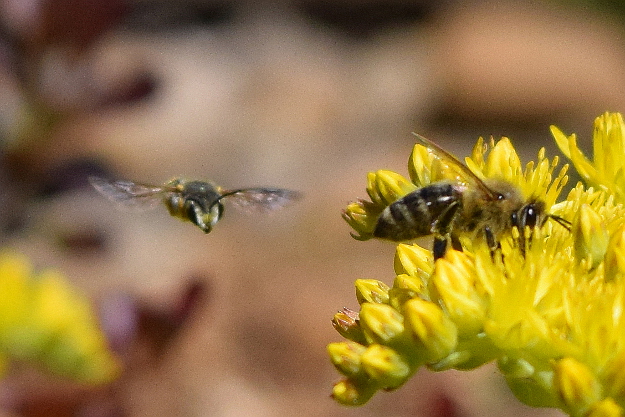
Nature shows always get you to root for the protagonist, whoever that may be. If the star of the show’s a fox, you’ll find yourself cheering her on to catch the rabbit (although you may have cheered for the rabbit in a previous episode). If the subject’s a skunk, you’ll wish him well as you watch him go about his day. And if the hero’s a European wool carder bee (Anthidium manicatum), you’ll cheer for him, too—even though he’s kind of a heel.

I say he, because it’s the males who give this species its thuggish reputation. The peaceable females are known for their habit of scraping the fuzz from woolly-leaved plants to line their nests with (hence the name “wool carder bee”), while the males are known for their aggression. They will body slam and drive off any other wool carder males, honey bees, bumble bees, or various interlopers that dare to enter their no-fly zones.
I’ve been watching the European wool carder bees for a couple of weeks on the nature show playing in my Portland, Oregon backyard, and the little bullies have made for some entertaining programming.
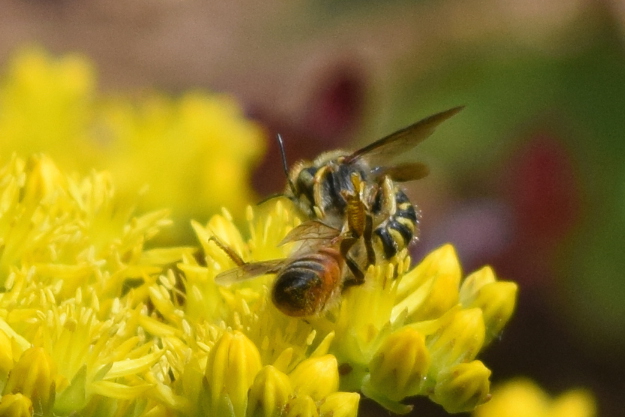

European wool carder bees are slow to rise on chilly mornings, needing the warmth of the sun to get them moving. They usually begin foraging by late morning. I first noticed them on my Teucrium hircanicum, a hardy perennial from Iran that’s loaded with spikes of tiny purple flowers. I later spotted many more on my Sedum reflexum ‘Blue Spruce’. The bees on my sedum are smaller, less hairy, and more feisty than the others, and I almost wonder if they are another species of Anthidium, though I don’t think so.

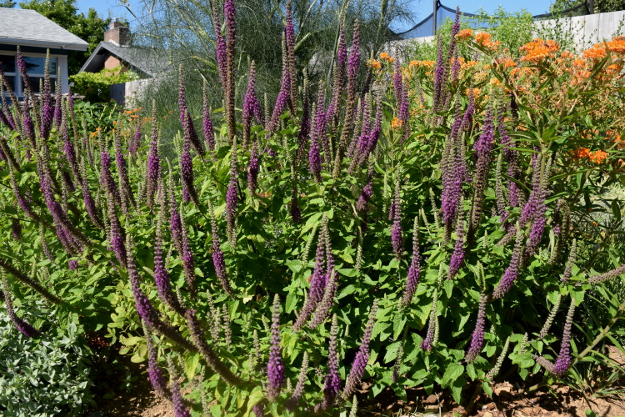

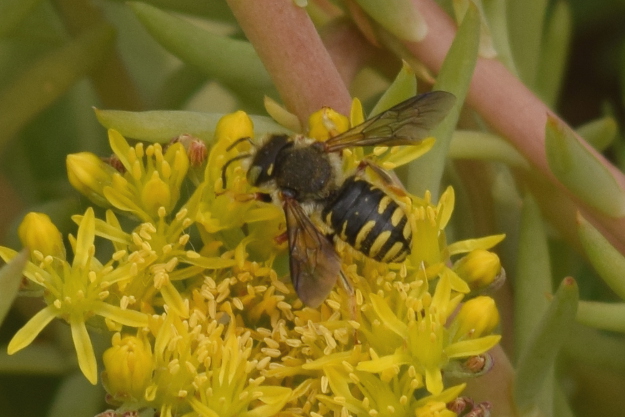
The male wool carders on my teucrium are about the size of honey bees, but with stouter bodies. Females are significantly smaller than males and have similar yellow and black markings.

Once the weather warms up, male wool carder bees become less interested in foraging and more interested in fighting. A dominant male will hover and dart with the deftness of a drone, picking off rivals (mostly honey bees) who enter a flower patch reserved exclusively for him and his female companions.
Wool carder bees’ main fighting tactic is to fly directly at the opponent and knock her off her perch, followed by a high-speed chase if she doesn’t get the message. Male European wool carder bees don’t have a stinger, but they do have barbs on the tip of their abdomen to assist in combat. They’re fearless fighters and don’t hesitate to take on bumble bees that are much larger than themselves.
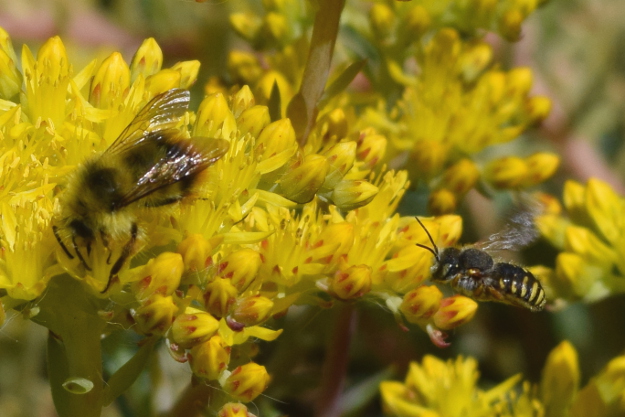


Trespassers usually take the hint and go elsewhere. I did see a few honey bees that persisted, only to be attacked again and again. They began to get sluggish and it was a little painful to watch, like the boxing scene in Cool Hand Luke: “Stay down, Luke! You’re beat.” I also witnessed a few honey bees become gravely injured.
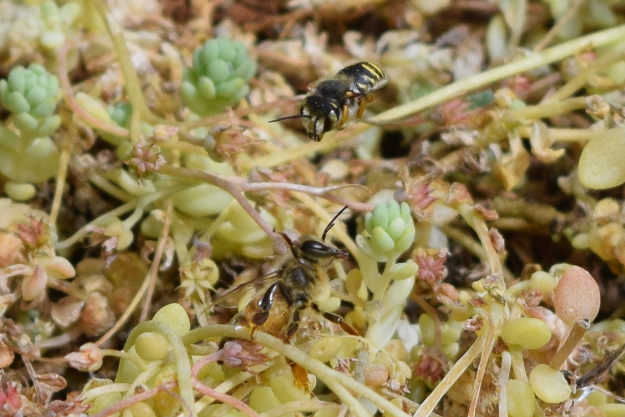
Male European wool carder bees don’t fight to defend feeding grounds for themselves—they fight to defend a food source for their harem of females. Of course, they don’t do this to be chivalrous, but for breeding rights. For most species of bees, it’s rare to witness a pair mating in the wild, but it’s hard not to see wool carder bees mating if they’re out and about. They have zero sense of propriety.
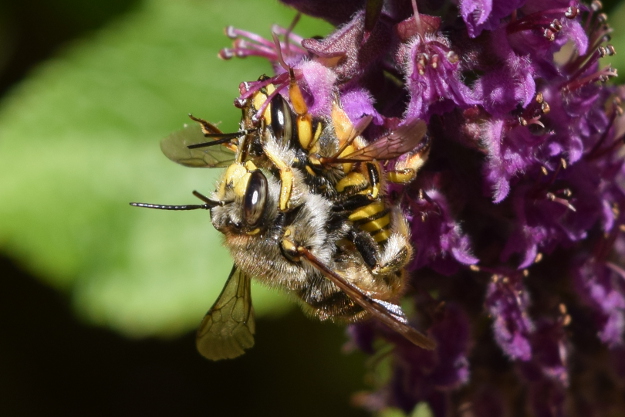
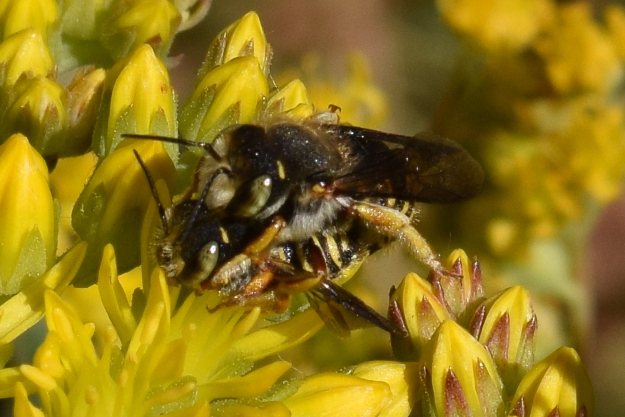

Right next to my patch of teucrium and 10 feet from my sedum, I have a fat clump of Big Ears lamb’s ears (Stachys byzantina ‘Helen von Stein’). When I put it in a couple of years ago, I unwittingly planted a European wool carder bee welcome mat. Lamb’s ears is their favored plant for “carding.”
When the shadows begin to fall over the garden in early evening, the females stop feeding, go to my lamb’s ears, crawl under a leaf, and scrape off some fuzz into a little cotton ball. They will take this home and line their nests with it. Wool carders aren’t hive dwellers, but solitary bees that live in holes or cracks they find in wood or stems or in the ground.
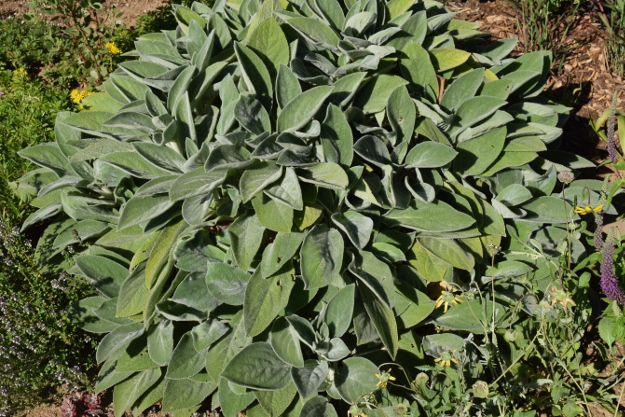
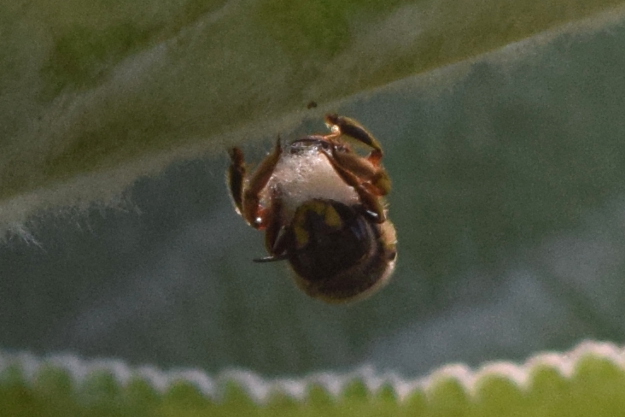

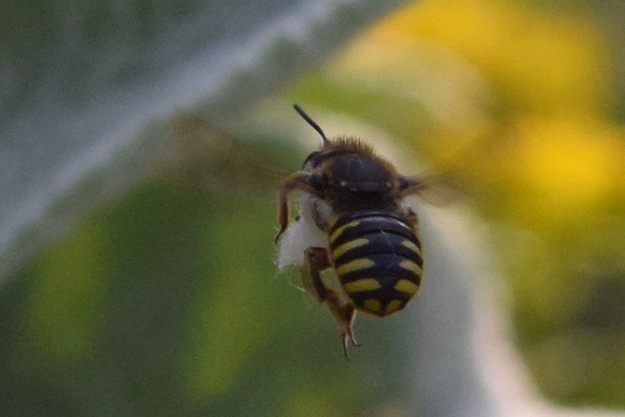
The European wool carder bee (Anthidium manicatum) was accidentally brought to the U.S. around 1963. It arrived in New York and has since spread across the country. It was first spotted in California in 2007, so it’s a relative newcomer here on the West Coast.
There’s been some concern that this exotic import could become a pest, attacking as it does our native pollinators as well as our non-native but valuable and beleaguered honey bees (American beekeepers lost 44% of their colonies in the 2015-2016 season from various causes). Certainly, their impact here is something we should keep an eye on, but for now it seems the wool carder bees’ damage is minimal, and they do accomplish a good deal of pollinating in between sessions of fighting, lovemaking, and carding.
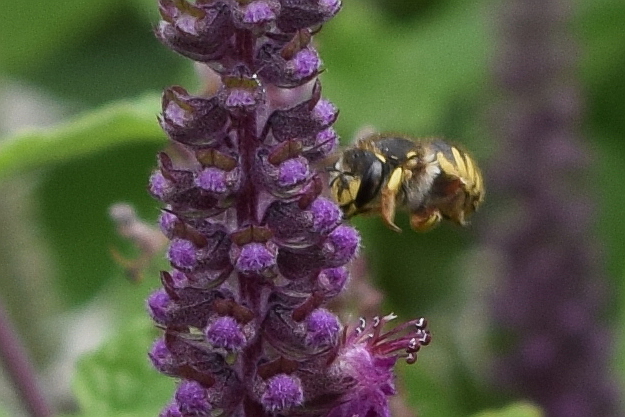
I have to say, I can’t help but like the little bullies.


How fun are these guys?! I’ll look more closely next time I see a chunky bee on a flower. I have Stachys ”Helen Von Stein’ too, so I’ll check it out for more fun there.
Look for the hovering, the zippy flight pattern, and the knock-downs. The visits to the lamb’s ears are brief and hard to capture unless you know exactly when and where to look.
I’ll have to take a closer look at my Teucrium . There are plenty of bees , but I can never Id any of them .
I can’t identify any of the others, besides honey bees and bumbles, but I am getting to know them. These are pretty easy to distinguish.
Out to eradicate every Wool Carder I see here in my garden. They are taking out honey bees at an alarming rate and often leave them minus a wing, doomed to die. I will find their nests and nuke the F*** out of them at every opportunity. Yet another pest species that we have had come into NZ in recent years.
These are non-native bees that we do not want killing or blocking resources from honeybees. Even though they may be fun to watch, they are dangerous to our rapidly declining honeybee population. Honeybees are extremely important & if you have the chance to eliminate any European wool carder bees, you should.
There’re no honeybees (Apis spp.) native to the Americas. Apis mellifera (European honeybee) is introduced there just like Anthidium manicatum. And it is not *extremely important*, it’s as important as any other bee. Also, there many native Anthidium spp in the USA that are just as territorial. It’s useless and wrong to “eliminate” them.
Please don’t neglect to mention that honey bees are non-native as well 😉 persisting to the detriment to native pollinators
I thought these feisty bees were flies, due to their zippy nature and apparent mimicry, glad I finally got a picture to ID them. They loved my salvia ‘hot lips,’ and, since I no longer grow that, they protect the catmint in the same pot. I’ve observed them for about five years now, laying claim to the same territory.
Well written and informed piece!
With respect !!!
I have Silver Lace Dusty Millers and the Wool Carder Bees love them. They collect the silvery dust off the leaves leaving green paths. It’s neat to see them fly away to their nest with a ball of silvery dust.
Personally, I find them vastly entertaining. Ya gotta admire something that small that doesn’t even hesitate to bash a big critter like a bumble or carpenter bee.
I discovered them for the first time these last two summers when they patrol my salvia plant. Find myself going out several times daily just to check them out. I live in Eugene, Oregon.
Just love your article and the intricate photos. I’m really fascinated with all pollinators; been fun trying to identify each one I see.
I’ve gone from having a HUMMING bee garden in 2018 to having a bee graveyard. Honeybees, bumbles and our very small native bees previously swamped the lavendar and oregano but have been out competed by the wool carders.
It wasn’t until 2019/2020 when I spent the growing season observing the carder behaviours to realise that the carders in NZ are aggressive; female and male. Unsure if the behaviour differs in NZ or whether observers just haven’t observed. The females will furiously feed, but if they’re in the same plant as other bees, they’ll divebomb them just like a male does. The males are easy to see due to their size. The males don’t stop the aggression until every bee is gone. They are like the Sentinels from The Matrix.
Carders are recently introduced to NZ (2006/2008), and unlike the US commenters, we have a LOT of native bees that clearly need protection from these thugs. They don’t just drive other bees out to feed elsewhere, they maim and kill. It was a sad sight to see a male take out a bumblebee mid flight just minding his business.
So after observing the carders for a season, I’m with Pete and Diana. I can honestly say that I don’t find them fun to watch, they horrify me. The carders take an easy food source, they don’t pollinate everything in the garden like our other bee combination, they’re hunguses (greedy for everything) and they’re killers. This last year I’ve found that swatting with a large flat metal slotted spoon is most effective or instecticidal spray directly into a hidey hole nest if you can find them.
Unlike Ivan saying it’s useless to try to eliminate them, it’s useless to sit back and do nothing. I view every carder that I eliminate from my garden as successful, not useless. If it allows the bees to forage for a day undisturbed in my garden, I’m happy with that. It allows me time to see what else is happening in my garden and be outdoors.
I’m wondering if planting a lambsear and applying insecticide to the underside of it will be a good way to combat the carders…
Since I wrote this article, I’ve learned a lot about our native bees, and now I don’t find these exotic bees nearly so cute. I haven’t started killing them, but I don’t think it would be wrong to do so. I really hate the idea of using insecticides on them, though, because of the risk of killing other innocent insects in the process.
I’m so sorry to hear that carder bees are such a problem in New Zealand and that they have done so much harm in your garden. Here in Oregon, they are a minor nuisance. I have realized there are two different species here, Anthidium manicatum and A. oblongatum. In my garden, both seem to stick mainly to the European plants… lamb’s ear, teucrium, birdsfoot trefoil, certain sedums, foxglove… They aren’t too interested in the native plants, and I have tons of native bees that visit my natives, and they aren’t harassed by the carders there. So maybe you could try planting more native New Zealand pollinator plants in your garden and cut back on the European plants and see if that helps bring the native bees back. BTW, you probably already know this, but there are no native bumble bees in New Zealand. There were a few species brought in from England to pollinate clover and they got established in the wild.
I disagree with the title Likable Bullies….. the’ bullies’ part is correct, however.
I have a rather small garden and find at least 5- 10 dead or dying 1-winged honeybees a day. It’s heartbreaking.
Seems like a big waste of money but I think I will be removing the salvia that they and the honeybees both seem to like so much.
My wife planted Lambs Ears in the garden about 3 months ago… now we have wool carder bees… have never seen them before anywhere until now.
Has anyone found an easy way to kill them in mass?